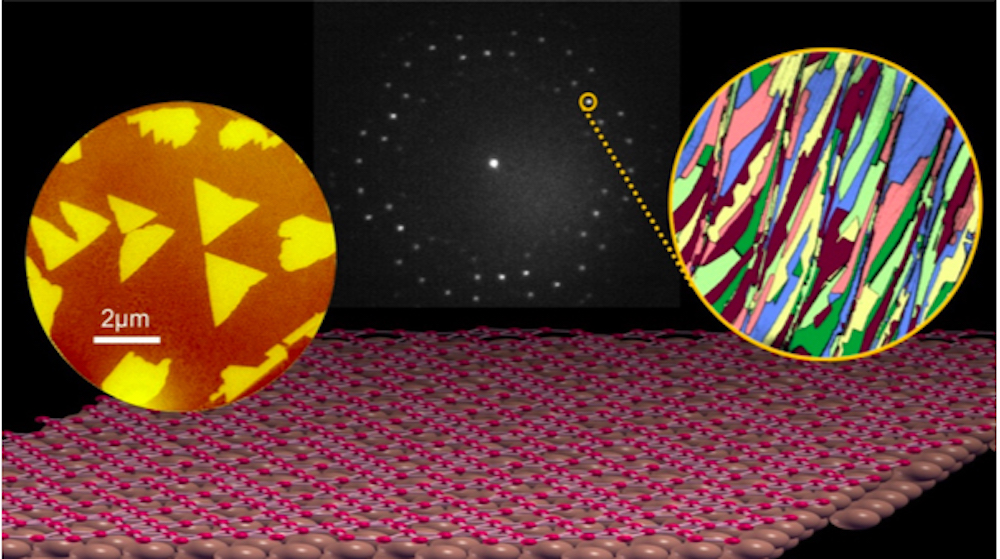
[Image above] Brookhaven National Laboratory and Yale University scientists used a low-energy electron microscope to watch “islands” of borophene (yellow triangles in left circle) grow. The islands grew until the entire substrate was covered in borophene (right circle). Each color represents one of six possible orientations of borophene crystals. Credit: Brookhaven National Laboratory and Yale University
When it comes to 2D materials, graphene is the darling of both academia and industry. What other 2D material has an innovation center opened solely in its honor or stands so close to achieving commercial-scale production for use in electronic devices?
But for all the focus on graphene, it does face some drawbacks. In particular, the chemical bonds between carbon atoms that give graphene its strength also make manipulating graphene’s structure difficult.
While techniques exist to control graphene’s shape, scientists have also wondered if another 2D material could exhibit the same impressive properties of graphene but allow for easier structural manipulation.
Borophene, a 2D sheet of boron atoms, is similar to graphene—both are flexible, strong, and lightweight, though borophene is even more so (which is why some feel it may serve wearable device applications better than graphene). Borophene was first theorized in the 1990s, but it was not experimentally confirmed until 2015.
Soon after the first confirmed synthesis of borophene, another group also achieved synthesis. However, even though both groups used silver substrates to grow their borophene, each group proposed entirely different crystal structures of the material. How was this possible?
“Borophene is different [than graphene] in that it periodically has an extra boron atom in the center of the hexagon,” says Ivan Božović, senior scientist and Molecular Beam Epitaxy Group Leader at Brookhaven National Laboratory and adjunct professor of applied physics at Yale University, in a Brookhaven news release. “The crystal structure tends to be theoretically stable when about four out of every five center positions are occupied and one is vacant.” What this means is that while number of vacancies is fixed, arrangement of boron atoms is not, allowing borophene to have multiple configurations—and thus easier structural manipulation!
Božović is part of a team made up of physicists from Brookhaven National Laboratory and Yale University that took a close look at borophene’s potential as a foundation to fabricate next-generation electronics. In their recent study published in Nature Nanotechnology, the researchers set out to do two things: 1) confirm existence of the two previously seen crystal structures and understand why they occur, and 2) see if they could grow large-area single-crystal domains of borophene (previously only nanometer-size single-crystal flakes have been produced).
To achieve their first goal, the researchers synthesized borophene on silver substrates, as the previous two studies had done. They found both structures do exist, and temperature dictates which structure will grow. Then, to achieve their second goal, the researchers moved into unchartered territory—growing borophene on a copper substrate instead of silver.
“From theoretical insights, we expected copper to produce larger single crystals because it interacts more strongly with borophene than silver,” says Božović. “Copper donates some electrons to stabilize borophene, but the materials do not interact too much as to form a compound.”
After growing borophene on copper substrate, they performed multiple rounds of experimental and theoretical checks in an iterative process until theory and experiment agreed—at which time they came to a few conclusions. “Not only are the single crystals larger, but the structures of borophene on copper are different from any of those grown on silver,” Bozovic says.
According to the Brookhaven news release, the next step is to transfer borophene sheets from the metallic copper surfaces to insulating device-compatible substrates. Looking further ahead, Božović and others anticipate testing borophene for superconducting capabilities. As the news release notes, “Some theorists have speculated [borophene’s] unusual electronic structure may even open a path to lossless transmission of electricity at room temperature, as opposed to the ultracold temperatures usually required for superconductivity.”
The paper, published in Nature Nanotechnology, is “Large-area single-crystal sheets of borophene on Cu(111) surfaces” (DOI: 10.1038/s41565-018-0317-6).
